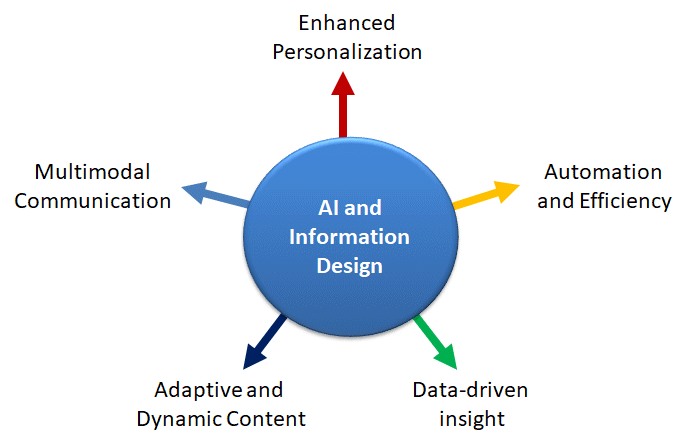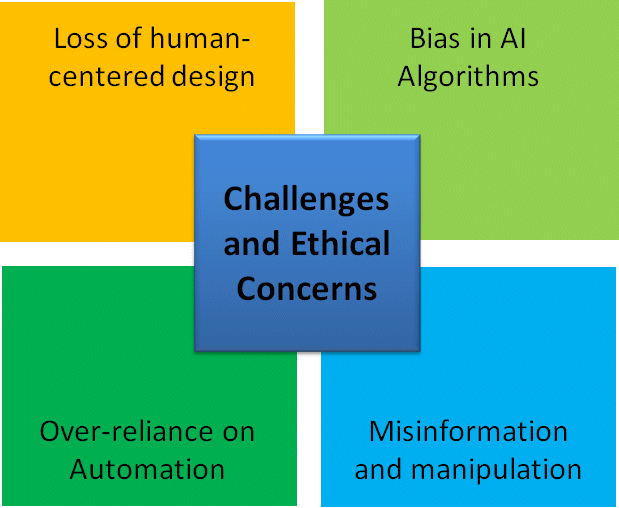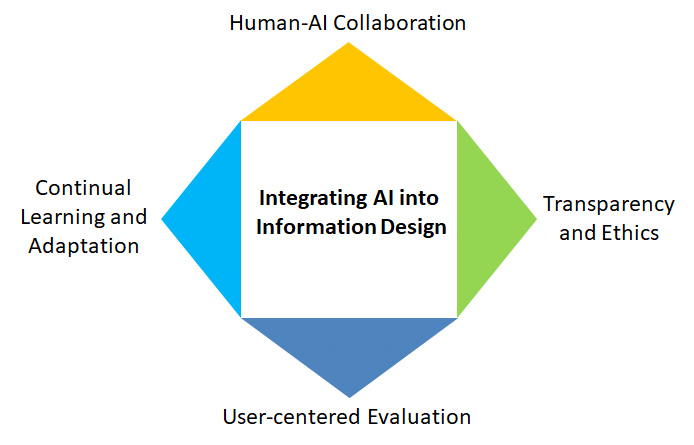
Introduction
I nformation design is undergoing a fundamental shift as artificial intelligence increasingly shapes how we produce, present, and personalize information. Traditionally concerned with making complex ideas accessible, intuitive, and meaningful, the field has long relied on human judgment, empathy, and creativity to craft experiences that help users navigate and understand content. As digital environments become more complex and data-rich, the demand for clear, adaptive, and user-centered information design has never been more pressing.The emergence of AI brings powerful new tools to this task, offering capabilities such as automation, personalization, real-time data analysis, and multimodal integration. These technologies allow designers to scale their work, streamline processes, and create more dynamic, responsive content than ever before. Yet with these opportunities come critical questions about the role of human agency, the risks of bias, and the potential erosion of design principles rooted in empathy and inclusivity. This Think-Piece explores the evolving relationship between AI and information design, highlighting the ways in which AI enhances design processes while also presenting new challenges. By examining both the benefits and limitations of AI, and by outlining strategies for responsible and effective integration, the paper aims to guide designers, educators, and policymakers toward an informed and balanced approach. As we navigate this changing landscape, the core question remains: how can we harness AI in a way that deepens-not diminishes-our ability to communicate meaningfully with diverse audiences? How AI Enhances Information Design AI is revolutionizing information design by introducing automation, personalization, and dynamic adaptability. By leveraging AI-powered tools, designers can optimize workflows, analyze large datasets, and create more engaging and responsive content. Some of the key ways in which AI enhances the field include: 
Figure 1: AI Enhancing Information Design AI is transforming the way information is presented by enabling enhanced personalization. By analyzing user behavior, preferences, and contextual data, AI systems can tailor content to individual needs. This level of customization improves user comprehension and keeps audiences more engaged, as the information presented feels more relevant and accessible. It moves away from a one-size-fits-all model and instead supports more meaningful interactions with content. In the realm of design, AI also significantly boosts efficiency through automation. Tasks that once took considerable time, such as formatting documents, optimizing layout structures, and generating data visualizations, can now be handled swiftly by AI-powered tools. This frees up human designers to concentrate on higher-level strategy and creativity, leading to more innovative and user-centered design outcomes. Another key contribution of AI lies in its capacity to extract data-driven insights. By analyzing large datasets on how users interact with content, AI can help refine design strategies to better meet user needs. This continuous feedback loop allows for the ongoing improvement of content presentation, ensuring it remains effective and user-friendly as user expectations evolve. AI also supports the creation of adaptive and dynamic content. Whether it's optimizing information for different screen sizes, translating into multiple languages, or adjusting for varying accessibility requirements, AI can ensure that content remains inclusive and responsive. This adaptability is crucial in reaching diverse audiences and ensuring equitable access to information across platforms and demographics. AI ultimately enriches information experiences through multimodal communication. By seamlessly integrating text, images, audio, and interactive elements, AI facilitates more immersive and engaging content. This holistic approach to communication allows for more effective storytelling and knowledge transfer, catering to different learning styles and user preferences. As a result, AI is reshaping how we design and consume information in increasingly sophisticated ways. Challenges and Ethical Concerns While AI offers numerous benefits, it also raises critical ethical and practical challenges. AI-driven automation can sometimes overlook human-centered design principles, introduce biases, or even contribute to misinformation. As information designers incorporate AI into their work, they must remain vigilant about the following concerns: 
Figure 2: Challenges and Ethical Concerns
While AI offers powerful capabilities in optimizing layouts and generating content, it can also lead to a departure from human-centered design principles. Human emotions, social contexts, and subtle communication cues are often difficult for AI to fully grasp. As a result, designs produced by AI might lack the empathy, cultural sensitivity, and intuitive flow that come naturally through human insight. This can diminish the overall user experience, especially when emotional or nuanced communication is essential. Another pressing concern is the presence of bias within AI algorithms. These systems often learn from historical or unbalanced datasets, which can embed existing stereotypes or systemic biases into their outputs. When such biased models are used to structure or deliver information, they can inadvertently reinforce misinformation or marginalize certain groups. This raises serious ethical implications, especially in public-facing content or educational materials where fairness and accuracy are paramount. There is also a growing risk of over-reliance on AI-driven automation in the design process. While automation enhances efficiency, it can sometimes lead to cookie-cutter outputs that feel generic and lack innovation. Creative direction, storytelling, and emotional resonance are areas where human designers excel, and diminishing their role could result in designs that fail to captivate or inspire users. Maintaining a balance between automation and human creativity is essential to preserving originality and depth in design work. AI also introduces new challenges in maintaining the integrity of information. The ability of AI to generate content at scale has enabled the rise of manipulated media such as deepfakes and convincingly written but misleading reports. These tools can be exploited to distort reality, spread disinformation, or erode trust in legitimate sources. As AI-generated content becomes more sophisticated, it is increasingly important to develop safeguards that can detect manipulation and uphold the credibility of information. Together, these challenges highlight the need for critical oversight and ethical frameworks in the use of AI for information design. While the technology offers unprecedented opportunities, it must be guided by human judgment, cultural awareness, and a strong commitment to truthfulness and inclusivity. Strategic Approaches for Integrating AI into Information Design To navigate the AI-driven evolution of information design, professionals must adopt a balanced approach AI is most effective when used to support, rather than replace, human creativity and judgment. Human-AI collaboration emphasizes the importance of designers taking the lead in directing AI tools. By treating AI as an assistant, designers can harness its capabilities to enhance efficiency and scale, while ensuring that the final output remains aligned with human-centered design values. This collaborative approach allows for the strengths of both human insight and machine precision to be fully realized. 
Figure 3: Strategic Approaches for Integrating AI into Information Design Transparency and ethics are fundamental to the responsible use of AI in information design. Organizations must adopt clear ethical frameworks that guide the development and application of AI tools. These frameworks should prioritize fairness, accountability, and inclusivity, especially when it comes to mitigating algorithmic bias and ensuring that AI-generated content reflects diverse perspectives. Establishing transparent processes also helps build user trust and ensures that AI is used in ways that uphold integrity. As AI technology evolves rapidly, continuous learning is essential for design professionals. Staying updated on AI advancements enables designers to make informed choices about which tools to use and how to use them effectively. More importantly, it helps maintain a balance between leveraging AI capabilities and preserving the core principles of good design. Lifelong learning ensures that designers can adapt their methods to meet emerging challenges and opportunities in a tech-driven environment. Equally important is the practice of rigorous user-centered evaluation. AI-generated designs should not be considered complete without thorough testing involving real users. These evaluations help assess whether the content meets key standards of accessibility, clarity, and engagement. By incorporating feedback from diverse user groups, designers can identify and address shortcomings in AI-generated content, ensuring that it truly serves the needs of its intended audience. Together, these practices form the foundation for integrating AI into design in a thoughtful and responsible manner. Rather than viewing AI as a substitute for human creativity, these principles emphasize partnership, ethical responsibility, ongoing growth, and user validation as the pillars of successful information design in the age of AI. Future Trends in AI and Information Design Looking ahead, several emerging trends will shape the future of information design: AI is set to play a pivotal role in enhancing creativity across the design landscape. By assisting designers in generating innovative visualizations, dynamic interfaces, and adaptive storytelling formats, AI can unlock new dimensions of creative expression. Rather than replacing the creative process, AI acts as a powerful tool that expands what is possible, offering suggestions, variations, and complex integrations that may not have been easily achievable through manual efforts alone. This AI-augmented creativity enables the crafting of richer, more engaging experiences for users. 
Figure 4: Future Trends in AI and Information Design Voice and conversational interfaces represent a significant shift in how users interact with information. AI-driven tools such as voice assistants and chatbots are becoming more embedded in digital ecosystems, allowing for hands-free, intuitive, and personalized information access. These interfaces not only offer new ways to navigate and present content but also make interactions more natural and user-friendly. As these technologies mature, they will enable seamless communication, especially in contexts where visual or manual input is limited or impractical. Real-time data visualization is another area where AI is driving major advancements. By rapidly analyzing and interpreting large volumes of data, AI-powered analytics platforms can generate instant visual insights. This capability enhances decision-making by presenting up-to-date information in digestible formats, allowing users to respond to changing conditions as they unfold. Whether used in business intelligence, journalism, or public communication, real-time visualization adds clarity, speed, and relevance to data-driven narratives. Accessibility will also benefit significantly from AI innovations. Through features like automatic content summaries, real-time translations, and adaptive layout adjustments, AI can help make information more inclusive and easier to consume for diverse audiences. These tools reduce barriers for individuals with disabilities, language differences, or varying levels of digital literacy. By embedding accessibility into the design process through AI, content creators can ensure their messages reach and resonate with as wide an audience as possible. AI (Eye) on the Future
However, these benefits do not come without risk. Over-reliance on automation, the persistence of algorithmic bias, and the potential for misinformation highlight the importance of human oversight. The values of transparency, ethics, creativity, and user-centered thinking must remain central as we integrate AI into our workflows. Designers must act not just as users of AI, but as stewards of its responsible application, ensuring that information remains trustworthy, accessible, and grounded in human experience.
As AI continues to evolve, so too must the strategies and skillsets of those working in information design. Embracing lifelong learning, fostering human-AI collaboration, and embedding inclusive evaluation practices will be essential. Ultimately, AI should be seen not as a replacement for human creativity and judgment, but as a powerful partner in advancing the goals of clear, ethical, and engaging communication in the digital age.
|

